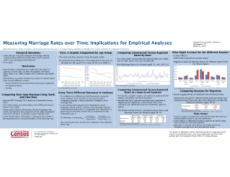
An official website of the United States government
Here’s how you know
Official websites use .gov
A .gov website belongs to an official government organization in the United States.
Secure .gov websites use HTTPS
A lock (
) or https:// means you’ve safely connected to the .gov website. Share sensitive information only on official, secure websites.
-
//
- Census.gov /
- Census Working Papers /
- Measuring marriage rates over time
Measuring marriage rates over time: Implications for empirical analyses
Measuring marriage rates over time: Implications for empirical analyses
Introduction
Marriage behavior has been the subject of extensive research across many academic disciplines. However, the marriage data used in this research have often been less than ideal. This research fills an important void assessing the use of alternate sources of marriage data for empirical analyses utilizing new questions on marital history in the American Community Survey. This work considers how data on marriage stock data (information on marital status) and marriage flow data (from information on marital history) might yield different results. We examine differences in descriptive estimates as well as exploring the relationship between aggregate unemployment rates and marriage rates using an ordinary least squares regression approach and considering the implications for a difference-in-differences approach. Results show marital status and marital history data yield divergent results in terms of sign and significance. Differential effects by cohort and differential migration patterns by marital status may contribute to this discrepancy. These results suggest using caution when conducting analyses using marital status data as they may produce false negative results or spurious false positive results.
Share
Some content on this site is available in several different electronic formats. Some of the files may require a plug-in or additional software to view.
 Yes
Yes
 No
NoComments or suggestions?


Top

